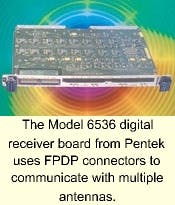By John McHale
UPPER SADDLE RIVER, N.J. - Engineers at Pentek Inc. have designed a new digital VME board with front panel data port (FPDP) connectivity for signal intelligence applications.
The Model 6536 is for original equipment manufacturers and systems integrators who address high-speed processing such as summation of multiple channels for beamforming applications, direction finding, demodulation, and decryption. The board handles other signal analysis tasks such as medical imaging and analysis of many forms of radar or sonar signals, Pentek officials say.
The cross-switching technology and the FPDP connectors of the board would enable systems designers to send several different signals on different channels to different destinations, says Rodger Hosking, vice president of marketing at Pentek, based in Upper Saddle River, N.J.
The configuration "allows you to bring as many as four different antennas into the board with a field-programmable gate array (FPGA), acting as a summation device capable of doing the beamforming calculations necessary for the direction finding application," Hosking continues.
Designers can configure the board to accept three 16-bit inputs or four 14-bit inputs. Each of the two 32-bit FPDP connectors supplies two parallel digital inputs at clock rates as fast as 40 MHz. Available to drive these 14- or 16-bit inputs are
Pentek's family of 64xx series dual-channel A-D converter boards with sampling rates ranging from 250 kHz to 40 MHz with accuracies from 12 to 16 bits.
Pentek's device accepts digitized data from four parallel inputs at sampling rates as fast as 40 MHz. The 6536 is also compatible with Pentek's high-speed buffer memory board, TMS320C6x digital signal processor (DSP) boards, and the many FPDP products available from other vendors.
"The Model 6536 features the new Graychip GC4016 quad receiver chip that not only includes an internal cross-bar switch to handle all four inputs, but also features a separate re-sampling stage at each receiver output," Hosking says.
Systems designers can configure the Model 6536 with as many as 32-channels of narrowband receivers to perform frequency down-conversion, lowpass filtering, and decimation of the sampled output. Each of the 32 receivers can independently select any one of the four A-D input sources.
The Model 6536 receiver output signals are first processed in a FPGA that performs serial-to-parallel conversion as well as some simple high-speed pre-processing tasks including summation of multiple channels for beamforming applications, Pentek officials say.
The FPGA outputs then go into FIFO memory buffers as large as 64k samples deep. The FIFO outputs can go to any of Pentek's DSP boards, to the VMEbus, or to an on-board TMS320C40 DSP capable of performing demodulation, decryption, and other signal analysis tasks.
The new Pentek board also uses Pentek's ReadyFlow software development package with its library of board-specific parameter definitions, header files, and high-level C-callable functions for each product.
The software library can eliminate the need for programmers to spend time dealing with low-level hardware details, Pentek officials say. ReadyFlow supports users through every step of the application development process from the time they open the box through system deployment.
null




